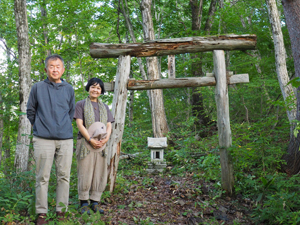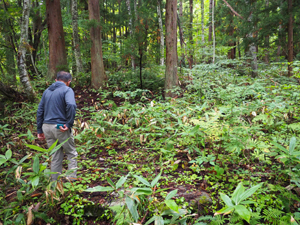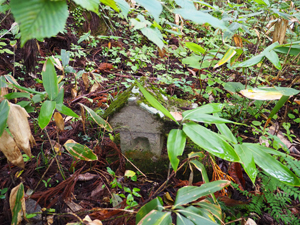Series “Visiting Villages” 40 What does it mean to close a community? Walking through the farm hut settlements of Showa Village, Fukushima Prefecture①
I walked through the farm hut settlements of Showa Village. Currently, no one lives there. The last residents moved to another area in 2017, and the settlement closed. How did the settlements close? I explored their trajectory. (Kei Kitajima)

菅家夫妻(Mr. and Mrs. Kanke)
After completing my interview at Showa Village Hall, I headed straight to Farmers Cafe Oashiya in the village to meet with Hiroaki Sugaya.
In addition to earning a living as a baby’s breath farmer, Sugaya is also an independent folklorist dedicated to researching and studying the culture and traditions of Showa Village. His field-based research style is reminiscent of Tsuneichi Miyamoto, known as the author of “The Forgotten Japanese.”
I met Mr. Sugaya and his wife, Yoko Sugaya, at Farmers Cafe Oashiya, and they guided me around the village, including the farm hut settlement.
Currently, no one lives in the farm hut settlement. The last residents moved to another area in 2017, and the settlement closed.
Hiroaki explains, “Farm hut has a long history, and during the Edo period it flourished as a settlement making bowls, the prototype for Aizu lacquerware.”
One of the last remaining residents of the farm hut settlement was Ogura Mataichi. He was well-liked by everyone as a cheerful old man who loved to joke around, and was so popular that he was even invited to appear on television programs. Ogura passed away in 2011, but as the last resident of Farm hut settlement, he single-handedly demolished the village’s shrine and returned the land to a vacant lot. He passed away two months after completing this work.
“The principal image of Hatagoya Shrine is in Oashi, so Mataichi consulted them, but they refused, saying that they could not take care of it. So Mataichi decided to demolish the shrine and clear the land. It’s common to hear of people demolishing their own houses and clearing the land before leaving a village, but Mataichi made closing the shrine, which is a sacred place in the village, one of his priorities. He seemed to think that when closing a village, it was best to close the shrine, which is a sacred place,” says Hiroaki.
Later, just before leaving the village, Sato Tomi, the last remaining resident, moved the Koyasu Kannon statue, which the women of the village worshipped, to a temple in the village center. This was in October 2017.
“Whether it’s a shrine or a Kannon statue, they’re symbols of the community, so I think it’s important for the residents who lived there to be there to see their loved ones through their final moments before leaving. It gives them a sense of spiritual relief,” says Hiroaki.

畑小屋集落。かつて大山祇神社があった場所(Hatagoya village. The site of the former Oyamazumi Shrine.)

大山祇神社があった場所に小さな祠が置かれている。かつて神社があった目印(A small shrine stands where Oyamazumi Shrine once stood.)
We entered Hatagoya Village. There are a few houses scattered around, but it’s clear at a glance that no one lives there. The houses were rotten and buried under pampas grass and bamboo leaves. It seems that this entire area used to be filled with fields, but now it’s completely covered in vegetation and unrecognizable.
Showa Village is in a heavy snowfall zone, with up to two meters of snow piled up in the winter. In inhabited areas, the village office sends out snowplows to clear the snow, but the snowplows never enter uninhabited areas. Areas that are no longer looked after by anyone are more susceptible to deterioration, including houses. In fact, looking around, there were several houses flattened by the weight of the snow.
Hiroaki shouted “Ho, hoo!” as he made his way through the bushes.
He shouted “Ho, hoo!” to scare off bears. This area is a bear habitat and there have been many reports of bear sightings, so caution is required.
“Ah, there it is, there it is.”
Hiroaki beckoned to me as he had spotted something. Following his beckoning hand, I made my way through the bushes and came across what looked like a stone shrine.
“It’s a landmark put there by Mataichi. I think he put it there to show that there used to be a shrine here,” Hiroaki explained. The small, moss-covered shrine had its own charm, and I became intrigued as to how the shrine came to be.
“What kind of shrine was it?” Hiroaki answered my question with ease.
“The Oyamazumi Shrine that stood here was enshrined as the god of the mountains. As I mentioned earlier, this was a settlement of woodworkers who made Aizu-nuri bowls. The god they worshiped has its headquarters in Ogura Valley in Shiga, which traces its origins to Prince Koretaka, the prince who is said to have invented the potter’s wheel. Shiga’s woodworkers dispersed all over the country, and it’s likely that the woodworkers at Hatagoya were part of that sect”.
※Translating Japanese articles into English with AI
